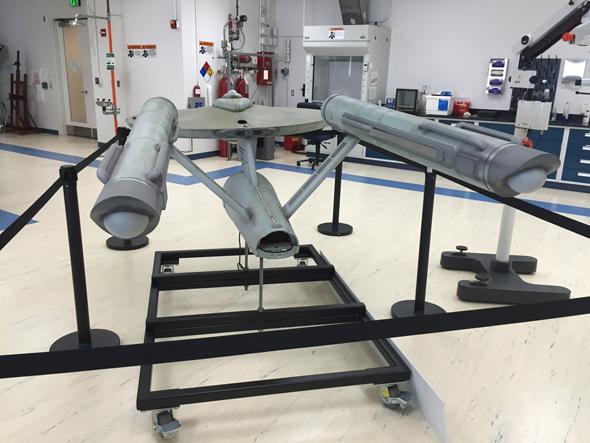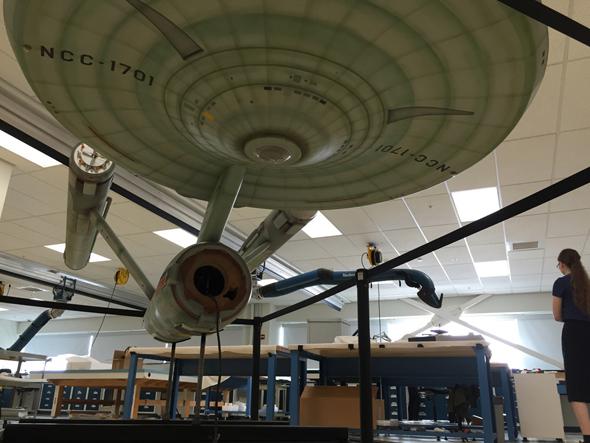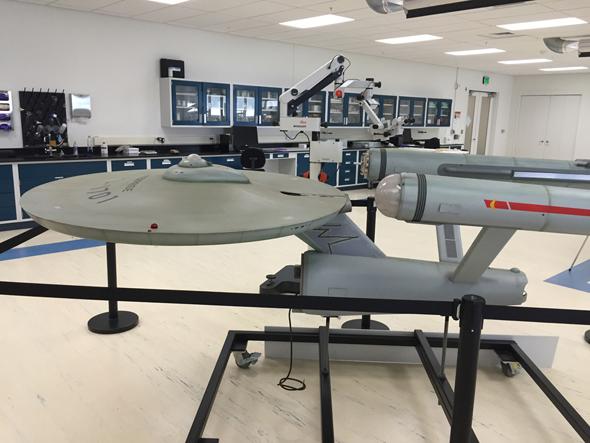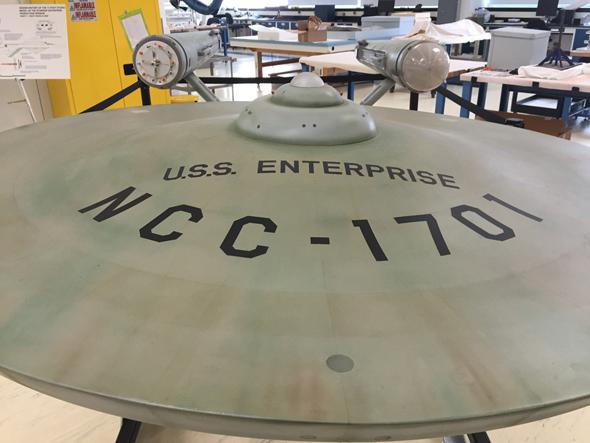This year marks the 50th anniversary of the most influential science-fiction series of all time: Star Trek. I’m a pretty big fan (Evidence A/B, Evidence 2, ad inifinitum), and I could go on and on about its influence, the characters, the music, and all that. But really, at the center of the show, there is one singular icon: the USS Enterprise.
Oh, that ship. Nothing had ever been seen like that before on TV or in movies — the unusual design and construction, unfettered by the need for gravity or aerodynamics or landing on a planet, yet still sleek and compelling.
For years the original model of the Big E used in the original series (or TOS to those of us in the know) was on display at the Smithsonian’s National Air and Space Museum. But the decades have taken their toll, and the model is currently undergoing reconstruction.
NASM has a great blog, and they just put up a wonderful article talking about the process. If you’re a Trek fan, this is a must-read. The pictures alone are worth it.

Phil Plait
As a huge Trek fan myself, I have to tell you about a time I got a piece of the action. Last year, NASM asked me to participate in a fundraiser to help preserve Neil Armstrong’s lunar EVA suit from Apollo 11. I talked with them on the phone about it,and joked that I’d love to be a part of that, but on one condition: I had to be able to see Enterprise myself.
They didn’t hesitate at all. “Of course,” was the reply I got.
“Oh,” I may have replied. I’m not sure, because my memory of that moment is a bit fuzzy. I may have blacked out for a second.
But they were serious. So when the time came … I boldly went.

Phil Plait
I went to the NASM Udvar-Hazy Center, where the spacesuit was being conserved. We spent the morning shooting some of the scenes for the promo video (including in a huge room with the Space Shuttle Orbiter Discovery hanging on display), which was fun. Then we moved to a part of the center where some of the real work is done: extremely talented professionals working on preserving and conserving priceless artifacts. We walked into the room where we were going to see Armstrong’s suit … and there she was.
Oh, that ship. Look: Seeing Armstrong’s suit up close (literally even being able to smell it) was a profoundly moving experience, and one I will cherish literally as long as I live. It represents the reality of space travel, of what we did when we had the will.
But that in no way diminishes seeing the Enterprise model, which represents our dream of space travel, of what we hope one day we’ll do. Inspiration comes from many directions, and those dreams play an important role in motivating the reality.

Phil Plait
So standing up close to Enterprise, the actual model used in the original series, was thrilling. Thrilling. The ship that started it all, right there in front of me.
It made me think about watching the show when it was in its first reruns, my older brother commenting to me about what was going on as the scenes unfolded (I was pretty young at the time). I had memories of watching Next Generation in grad school, bookending my career there (the first episode aired my first year, and the last one aired seven years later, just before I got my Ph.D.). I flashed back to standing in line at the theater to watch Wrath of Khan, and eventually meeting and even becoming friends with some of those galactic explorers.

Phil Plait
Making this encounter even better was meeting Ariel O’Connor, who is a conservator on the model. I wound up chatting with her about all manners of things; she is a font of information about it, with encyclopedic knowledge of its history. More than that, her affection for Enterprise is also readily apparent. Let me assure you, the NCC 1701 is in excellent hands. I’m not sure I’d trust it more if Kirk himself were in charge (after all, he didn’t always bring it home in the best of condition).
Even in its partially disassembled state, it was surreal to stand next to it. For one thing, it’s big: nearly four meters long. The coloring on it is odd, and they’re working on restoring it to its original hues. But even in that room, secured to its support stand, it looked ready to warp away to seek out brave new worlds.
I made a short video showing it; I had to speak softly as the crew was working behind me doing some video of Armstrong’s suit:
At one point, we realized it had to be moved to another spot in the room, or else it would be in our shots of the spacesuit. Several people hovered over it as they wheeled it a few meters over to the corner, and I practically swallowed my heart as they moved it. But these folks really are at the top of their game, and everything went very smoothly.
When we are all done filming, Armstrong’s suit was covered up and wheeled away, and we all headed out the door. As we did we filed right past Enterprise, taking up the corner of the room. I took one last lingering look, knowing how special this day was. It’s not often you get to see some of the greatest and most beautiful icons of space exploration history (both real and imagined) in your lifetime.
It’s not clear when the refit will be done, but at some point the model will be finished, and placed back on display at the museum. And when it does, I must return to this place again.

Phil Plait
My sincere thanks to the folks at NASM for letting me use these photos and write about this moment … and of course for giving me this chance to see Enterprise.
